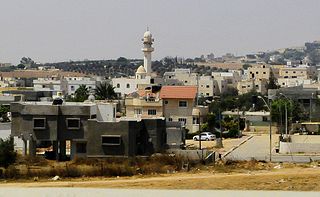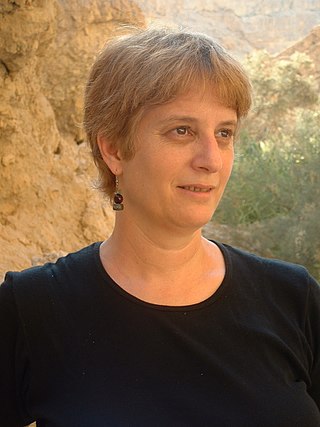
Ferdinand de Saussure was a Swiss linguist, semiotician and philosopher. His ideas laid a foundation for many significant developments in both linguistics and semiotics in the 20th century. He is widely considered one of the founders of 20th-century linguistics and one of two major founders of semiotics, or semiology, as Saussure called it.
Phonology is the branch of linguistics that studies how languages or dialects systematically organize their phones or, for sign languages, their constituent parts of signs. The term can also refer specifically to the sound or sign system of a particular language variety. At one time, the study of phonology related only to the study of the systems of phonemes in spoken languages, but may now relate to any linguistic analysis either:

Sign languages are languages that use the visual-manual modality to convey meaning, instead of spoken words. Sign languages are expressed through manual articulation in combination with non-manual markers. Sign languages are full-fledged natural languages with their own grammar and lexicon. Sign languages are not universal and are usually not mutually intelligible, although there are also similarities among different sign languages.
Nicaraguan Sign Language is a form of sign language which developed spontaneously among deaf children in a number of schools in Nicaragua in the 1980s. It is of particular interest to linguists as it offers them a unique opportunity to study what they believe to be the birth of a new language.
Al-Sayyid Bedouin Sign Language (ABSL) is a village sign language used by about 150 deaf and many hearing members of the al-Sayyid Bedouin tribe in the Negev desert of southern Israel.
Providence Island Sign Language is a village sign language of the small island community of Providence Island in the Western Caribbean, off the coast of Nicaragua but belonging to Colombia. The island is about 15 square miles (39 km2) and the total population is about 5000, of which an unusual proportion are deaf.
Israeli Sign Language, also known as Shassi or ISL, is the most commonly used sign language by the Deaf community of Israel. Some other sign languages are also used in Israel, among them Al-Sayyid Bedouin Sign Language.
Carol A. Padden is an American academic, author, and lecturer. She is a professor in the Department of Communication at the University of California, San Diego, where she has been teaching since 1983.

Al-Sayyid or al-Sayed is a Bedouin village in Israel. Located in the Negev desert between Arad and Beersheba and just south of Hura, it falls under the jurisdiction of al-Kasom Regional Council. In 2021 the village's population was 6,289.
Linguistics is the scientific study of language. It entails the comprehensive, systematic, objective, and precise analysis of all aspects of language — cognitive, social, environmental, biological as well as structural.
Saudi Sign Language is the deaf sign language of Saudi Arabia. This sign language is different from the Unified Arabic Sign Language that is used by 18 Arab countries. There are 100,000 deaf people in Saudi Arabia.
In sign languages, the term classifier construction refers to a morphological system that can express events and states. They use handshape classifiers to represent movement, location, and shape. Classifiers differ from signs in their morphology, namely in that signs consist of a single morpheme. Signs are composed of three meaningless phonological features: handshape, location, and movement. Classifiers, on the other hand, consist of many morphemes. Specifically, the handshape, location, and movement are all meaningful on their own. The handshape represents an entity and the hand's movement iconically represents the movement of that entity. The relative location of multiple entities can be represented iconically in two-handed constructions.
A village sign language, or village sign, also known as a shared sign language, is a local indigenous sign language used by both deaf and hearing in an area with a high incidence of congenital deafness. Meir et al. define a village sign language as one which "arise[s] in an existing, relatively insular community into which a number of deaf children are born." The term "rural sign language" refers to almost the same concept. In many cases, the sign language is known throughout the community by a large portion of the hearing population. These languages generally include signs derived from gestures used by the hearing population, so that neighboring village sign languages may be lexically similar without being actually related, due to local similarities in cultural gestures which preceded the sign languages. Most village sign languages are endangered due to the spread of formal education for the deaf, which use or generate deaf-community sign languages, such as a national or foreign sign language.
Algerian Jewish Sign Language (AJSL), also known as Ghardaia Sign Language, is a moribund village sign language originally of Ghardaïa, Algeria that is now used in Israel and possibly also in France.
A deaf-community or urban sign language is a sign language that emerges when deaf people who do not have a common language come together and form a community. This may be a formal situation, such as the establishment of a school for deaf students, or informal, such as migration to cities for employment and the subsequent gathering of deaf people for social purposes. An example of the first is Nicaraguan Sign Language, which emerged when deaf children in Nicaragua were brought together for the first time, and received only oral education; of the latter, Bamako Sign Language, which emerged among the tea circles of the uneducated deaf in the capital of Mali. Nicaraguan SL is now a language of instruction and is recognized as the national sign language; Bamako SL is not, and is threatened by the use of American Sign Language in schools for the deaf.
Diane Lillo-Martin is a Board of Trustees Distinguished Professor of Linguistics at the University of Connecticut. She is currently the Director of the university's Cognitive Sciences Program as well as its Coordinator of American Sign Language Studies. She spent 12 years as Head of the Department of Linguistics at the University of Connecticut.
Kafr Qasem Sign Language is a village sign language of Israel.
Juliette Blevins is an American linguist whose work has contributed to the fields of phonology, phonetics, historical linguistics, and typology. She is currently Professor of Linguistics at the Graduate Center, CUNY.

Irit Meir was an Israeli linguist, who specialized in the linguistics of sign languages. She was an associate professor in the Department of Hebrew Language and the Department of Communication Sciences and Disorders at the University of Haifa, and the associate director of the Sign Language Research Lab.
Cena is a village sign language used by 34 known deaf signers and many more hearing inhabitants of Várzea Queimada, a small, agricultural community in the sertão (scrubland) of Piauí, north-eastern Brazil. It is currently in its third generation of users.




